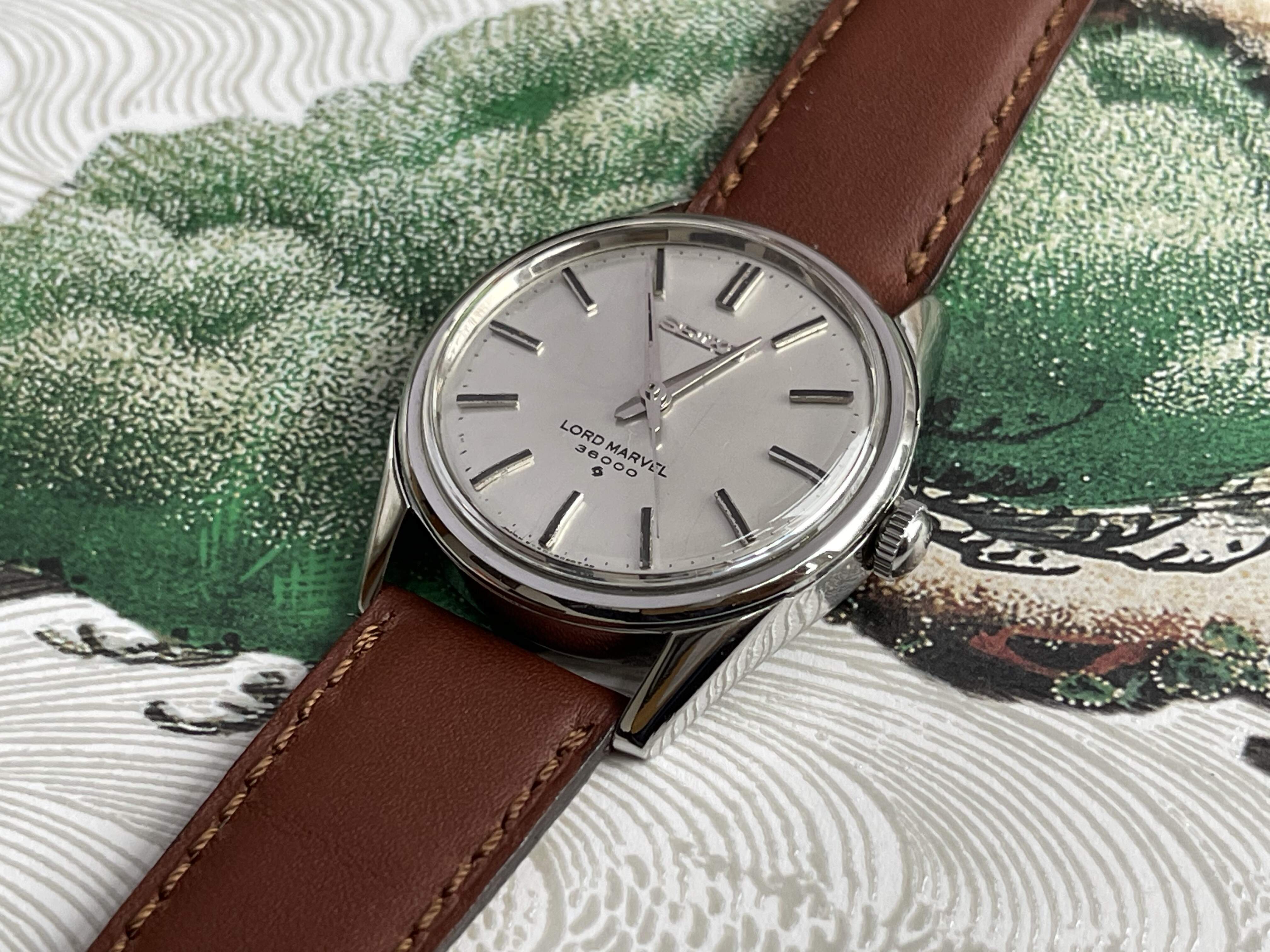
Seiko Lord Marvel 5740-8000 LM36-040 (Sold)
€ 615.00
Sold out
| About | Details | and then some |
|---|---|---|
| Manufacture | Seiko | Lord Marvel |
| Model reference | LM36-040 | 5740-8000 |
| Movement | Manual wind | 36.000bph |
| Caliber | 5740 | 8000 |
| Dial | Silver sunburst | |
| Case | 35x41x10mm | Steel |
| Lugs | 19mm | |
| Bracelet | Leather (not the one depicted) | 22cm |
| Crystal serial # | Unknown | Acrylic |
| Timegrapher | Amp 180 Err 0.9 | Accuracy: -2spd |
| Jewels | 23 | |
| Serial # | 70xxxx | Production: 1967-10 |
| Condition | Excellent | |
| Service | New crystal | |
| Box & Papers | No box | No papers |
In the sixties Seiko’s watch development exploded from the simpler compact line-up of the fifties. Virtually all mechanical watch movements then performed at a steady 18000 beat rate, that changed to 19800 bph or even 21600 bph. Fortunately, the accuracy of a watch depends on more than mechanical beat rate, even if the ability of the balance to recover from shocks is obviously very basic to that. The Diashock solution was introduced early on, as was the 360 degree dual wind rotor (without a stop).
The low beat Lord Marvel line debuted around 1959, but the high beat Lord Marvel 5740-8000 was manufactured between 1967 and 1978. The high beat 5740 is actually considered to be the 3rd generation Lord Marvel model, and it represents the peak of that line.
Seiko movements run at integer numbers of beats per second, ensuring an integer number of steps between minute markers. So, an early fifties 18000 bph movement runs at 5 bps, taking 5 steps between the indices, a 21600 bph movement runs at 6 “steps”, a 28800 bph at 8 steps and so on. There are always exceptions of course, such as the 19800 bph early Grand Seikos and the Rolex 1570 and 1575 (5.5 bps).
Although Seiko was always at the horological forefront it was not the first to get to the ultimate beat rate watch. In 1966 Girard-Perregaux already developed the automatic 32A movement, with a beat rate doubled to 36000 bph (10 bps or 5 Hz). It was an upgrade of the manual wind AS 1687/1688, made automatic by the joint effort of watch companies Doxa, Eberhard, Favre-Leuba, Girard-Perregaux and Zodiac.
In 1967 the Lord Marvel 36000 was Seiko’s answer to the European enterprise, of course developed entirely in house. Seiko, efficient as always, simply used the existing low beat hand-wind 5740B caliber movement that was used in the Seiko Crown 560 (from 1959). Seiko however did not evolve the movement complications or include a hacking mechanism, after all, this watch was the 36000bph experiment in its purest form. No daydate, no automatic module.
The release of a fully outfitted Grand Seiko 36000bph version however, the newly designed 61GS caliber, came that same year. And of course the following year (1968) rival Daini division launched their “Grand Seiko killer”, the King Seiko hand wind 45 calibre. It was also fitted however into the Grand Seikos that came later.
As stated the late sixties early seventies were filled with watch innovations, and design elements often marked the occasion. The case back for instance, it started off with the Seahorse but changed to the simple horse shoe, marked “Water Proof” or later "Water Resistant", with or without the Suwa logo. The horse shoe was used at the start of the Lord Marvel’s eleven year production span but was phased out in 1974, four years before the end of the line in 1978 to just basic lettering indicating the brand and movement, SGP or SS (imitiating what happened to the King Seiko Line, which lost its golden seal in the -7041).
The dial and the codes under the marker six are another matter entirely, Seiko used the 8020T AD (or for Arabic 8030T AD) rather than 8020 U (or for Arabic 8030 U). However, also the indication 8020T M/8030T M and -R was used instead of -AD.. On the ower half of the dial Lord Marvel 36000 was printed, as far as can be established these came in bold or non-bold font, with the 36000 finely printed (or not) with a "tall" or "compact" font. The same applies to the Suwa logo but apparently not to the SEIKO appliqué.
It is an interesting fact that Seiko used the same design elements across all their production lines and the Arabic versions are a nice example, with similarities between the Lord-Matic 5601 for instance and the Marvel striking as far as dimensions and dial size and design are concerned. The large Marvel crown of course stands out as do the long lugs - for a leather only watch it seems to be the very best esthetic option..






